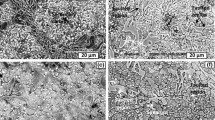Abstract
A series of twelve Cr-Mo white irons varying in carbide volume from 7 to 45 pct were tested for dynamic fracture toughness and wet sand abrasion resistance. Carbon content was varied from 1.4 to 3.9 pct. Two matrix microstructures were employed, and the compositions (copper and chromium content) were varied to assure constant matrix compositions. Chromium was varied from 11.6 to 25.7 pct. In addition, one composition of white iron was subjected to thirty different heat treatments to define the effect of matrix microstructure on dynamic fracture toughness and abrasion resistance. It was shown that for the abrasive wear system used, a carbide volume of about 30 pct represented an optimum quantity, above which abrasion resistance decreased. Martensitic irons provided consistently better abrasion resistance than austenitic irons. Dynamic fracture toughness decreased with carbide volume, as expected. Higher toughness values were obtained with predominantly austenitic matrix microstructures than with predominantly martensitic matrix microstructures. Considering both abrasion resistance and fracture toughness, it was shown that heat treated irons could provide an optimal combination of these properties.
Similar content being viewed by others
References
T. E. Norman, A. Solomon, and D. V. Doane:Trans. Am. Foundrymen’s Soc., 1959, vol. 67, pp. 242–56.
M. M. Kruschov:Proc. Conf. Lubrication and Wear, p. 665, Institution of Mechanical Engineers, London, 1957.
J. C. Hamaker and A. M. Bayer:Cobalt, 1968, no. 38, p. 3.
A. R. Rosenfield and A. J. McEvily: AGARD Rep. 1973, AGARD-R-610, pp. 24–54.
K. H. Zum Gahr:Arch. Eisenhuettenw., 1978, vol. 49, pp. 581–86.
E. Hornbogen and T. M. Motz:Int. Cast Metals J., 1977, vol. 2, p. 4.
K. H. Zum Gahr:Z. Metallic., 1977, vol. 68, pp. 783–92.
Wear of Materials -1979, K. C. Ludema, W. A. Glaser, and S. K. Rhee, eds., Part Two, Abrasion, p. 266, ASME, New York, 1979.
H. Czichos:Wear, 1977, vol. 41, pp. 45–55.
C. Kim: Unpublished research, Climax Molybdenum Company of Michigan, Ann Arbor, MI, 1977.
R. L. Miller:Trans. ASM, 1968, vol. 61, pp. 592–97.
F. Borik: SAE 700687, published September 1970 by Society of Automotive Engineers, New York.
Author information
Authors and Affiliations
Additional information
Formerly Visiting Research Metallurgist, Climax Molybdenum Co. Research Laboratory.
Rights and permissions
About this article
Cite this article
Gahr, KH.Z., Doane, D.V. Optimizing fracture toughness and abrasion resistance in white cast irons. Metall Trans A 11, 613–620 (1980). https://doi.org/10.1007/BF02670698
Received:
Issue Date:
DOI: https://doi.org/10.1007/BF02670698




